Gwalior Fort is a majestic structure located in Gwalior, one of the famous fort of Madhya Pradesh. Built atop a rocky hill, the fort dominates the skyline and offers a stunning panoramic view of the city. The fort has been witness to centuries of history and has been ruled by several dynasties, including the Tomars, Mughals, Marathas, and Scindias. The fort's architectural marvels, such as the Man Mandir Palace and the Teli ka Mandir, showcase a blend of Hindu, Islamic, and Jain influences. One of the unique features of the fort is its Sas-Bahu temples, dedicated to Lord Vishnu and adorned with intricate carvings. The fort's strategic location and impressive defenses, including the eight-kilometer-long ramparts, underground water tanks, and cannon emplacements, have made it an impregnable fortress. Today, the Gwalior Fort is a popular tourist attraction and a living testament to India's rich cultural heritage.
My Love for lesser known
I have an affinity for offbeat destinations, places that are
not as popular or mainstream. The allure of these places lies in their
unspoiled beauty and authenticity. Recently, my wanderlust led me to Gwalior, a
charming town nestled in the heart of Madhya Pradesh. Compared to the bustling
city life of the national capital, Gwalior offers a peaceful respite. Its
serene surroundings and tranquil atmosphere make it a perfect getaway for those
seeking solitude and tranquility. As I explored this lesser-known gem, I was
struck by its natural beauty and cultural richness, a true reflection of the
region's heritage.
Architecture
Gwalior fort was built on a rocky hill named Gopachal. One
can see the beauty of it from the foothill only. It was sand and stone like
built on a steep hilltop. I went there at monsoons and the greenery and
untouched beauty took a piece of my heart away. The fort was built by Maharaja
Man Singh on the 8th century. The fort is being known for its defense structure
and ability to control the town from this hilltop. Looking for an Offbeat
destination to explore? Checkout the awesome weekend trips here!
The lush green environment and the view from the fort
hilltop is something that cannot be missed in life. Once you enter the main
gate, is the steep climb for the fort. One side is the hill and the other side
is the moat, this is how the fort is surrounded by. Madhya Pradesh is dominated
by Jainism and here also you can see the same. On the way to the hilltop, one
can see the sculptures that reflect the Jain culture.
You can walk to the top if you are a real walker (the steep
and the fort is huge to discover like this).
Hidden Story
Gwalior Fort was at least 10th centuries old. But as per
locals, it was built by a local King Suraj Sen around 3 CE. For any historic
places, some or the other stories are famous, and this Palace also has a story
to tell us. As per the local people, King Suraj Sen was suffering for the
disease called Leprosy. A sage blessed him and with the water of a nearby pond,
the King was disease free. The sage also gave him a title “Pal” and told him
that their family will be the controller of this part of the country as long as
they use this given title. King “Suraj Sen Pal” and his family and many of his
descendants controlled the Fort for centuries. His 84th descendent lost it to
another King. This story is something that few locals told us and not even
mentioned in records.
History Behind
First time when it got recorded was on 10th century when the
fort was been controlled by Chandellas. Due to the position of the fort, it got
attacked many times by Mughal Emperors.
This is a place where may dynasties have controlled.
Starting from Chandelas, then it got controlled by Tomars, specifically King
Man Singh. After them, came was Sultan of Delhi Sikandar Lodhi. Then came the
Mughal Emperor and finally controlled by the British.
Present Days
After the British Raj and our Independence, the Raj Shashan
had been ended. However, the Scindia Family is still there and people respect
them as Raj Pariwar. Before Independence, they had built several monuments and
one of that is Jai Villas Mahal. One can still visit the Palace, as half of the
property has been converted to Museum.
Things there not to miss out: Inside fort premises,
there is a Gurudwara and 2 other temples.
Gurudwara
A holy place for worship for Sikh religion, they believe in
free service. A peaceful place to sit and have some self-introspection, this is
a perfect place to visit. You may also stay here as they provide free stay for
travelers.
This is a very evident example of the rich history and
culture of Gwalior fort. This also signifies that there were lots of dynasties
ruled from the fort and left their footprints behind.
Saas-Bahu Temple
the original name is “Sahastra-Bahu” means a thousand hands.
But with a due course of time, the name has been deteriorated and now known as
Saas-bahu temple.
Teli ka Mandir
Built by King Mihira
Bhoja, it is a perfect blend of north and south Indian architecture. The
building is now badly damaged but still, you can get some glimpses of this
architecture.
Jai Singh Palace / City Palace
Sindhia’s have converted half of the Palace to a museum
which is open to general public. Entry Ticket is there, and charges for the
camera is also applicable. The museum is full of ancestor’s remembrance. I
usually don’t like the museums, however, the main attraction that binds me was
the vast collection of chandeliers. I have never seen such a collection where
you can find Chand of any size that you can imagine of.
Tansen Music Fest
Gwalior and the great musician Tansen cannot be separated.
The festival is being celebrated every year on the last week of December. This
is s 4-day festival that attracts lots of classical music lovers to the city. I
never attended it but hope to visit the town at that point if time.
My Takeaway
The peace and tranquility of the city are the biggest
attraction of this place. The view from the hilltop of Gwalior fort is
mesmerizing. The simplicity of the locals is heart-warming. It is still
untouched by the extra modernization and that simplicity is the first thing
that fascinated me the most. I loved the city as it is and my love for the
unexplored part have multiplied many folds.








No comments:
Post a Comment